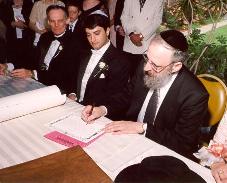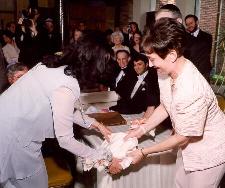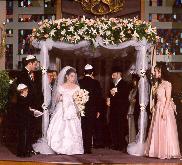Thank you for joining us on this very special day. We are pleased to welcome our family and friends from as far away as Vienna, Paris, and Caracas, as well as from all parts of the United States and Canada.
The Jewish wedding ceremony dates back many centuries and is filled with symbolism and ritual. In preparing for our wedding, we have learned much about our own traditions and heritage, and we would like to share this with you.
The ceremony was officiated by Rabbi Joseph Polak, Chaplain of the Boston University Hillel and member of the Beth Din of the Vaad HaRabbonim. Jodie has known the Rabbi since her freshman year at Simmons College when she started attending the services at the Hillel House. The Rabbi's role is to make sure that the ceremony meets the requirements of Jewish Law (Halacha). Also participating in the ceremony was Rabbi Jacob Mann of the Beth Israel Synagogue of Quincy. Rabbi Mann has led the congregation of Adam's father and grandparents since 1942.
Chosen's Tisch (Groom's table)
Separate receptions or parties were held for the bride and groom as the guests arrived. The Chosen's Tisch is the reception for the groom. All the guests gathered around the table where Adam was sitting in the foyer to sing and to toast him while Jodie was attended in a separate room by only her maid of honor and bridesmaids.
Tenayim (Agreement to marry)
Literally "conditions," this is a formal contract between the two sets of parents on the dowry and date of the wedding. Historically, the agreement was made at the time of engagement, and there were harsh consequences if the contract was broken. In recent times, the tenayim has been held later, sometimes only minutes before the ceremony, because anti-Semitic acts sometimes interfered with wedding plans. Today, the ceremony was done on the wedding day, mostly for its traditional or sentimental value. At its conclusion, a plate was broken by both mothers, to show the gravity of the contract; once it is broken, it can never be repaired.
Ketubah (Marriage Contract)
The Ketubah dates back to the 5th century B.C.E. It is a marriage contract that according to Jewish law must be signed by two witnesses unrelated to the bride or groom. The Ketubah raised the status of women in the time it was initiated, as it outlined the husband's obligations regarding food, clothing, and other necessities, and provided the wife with financial security.

Designed by Ardyn Halter, an Israeli artist, the Jerusalem Garden Ketubah, which we chose, shows a view of David's tower in the old city from a garden in Yemin Moshe. All around the Ketubah are vignettes of Jerusalem and a view of the Judean hills. The additional texts are from the Song of Songs and Psalms. We corresponded with the artist directly by e-mail, but he was busy designing stained glass in England and unable to personalize the Ketubah himself. Instead, Adam was the Sofer (calligrapher), personalizing the contract himself in Hebrew and in English.
In preparation for our own Ketubah, we were asked to find the Ketubot of our parents and grandparents. This helped the Rabbi verify our full Hebrew names, and confirm that ours was a proper Jewish marriage. To our delight, we were able to locate most of these documents. Adam found his paternal grandparents civil marriage contract on a recent visit to Vienna; their Ketubah was apparently lost when they fled during the second World War. It was in Vienna, on February 14, 1997, at the Opera House, where Adam proposed to Jodie during the intermission of Don Giovanni.
At the tisch, Rabbi Polak verified the Ketubah for accuracy and compliance with Jewish law. We did not actually sign the Aramaic portion of the contract, but the witnesses signed to certify that both of us had given our consent. During the wedding ceremony, the Ketubah was read aloud by Rabbi Mann, then given to Jodie to hold in her possession.
Then, Adam, the Rabbis, and our parents went off to the bedeken, while the guests found their seats in the sanctuary.
Bedeken (Veiling Ceremony)
The bedeken is an ancient custom, rooted in the Torah. Prior to the ceremony, Adam lowered Jodie's veil to be certain that it was she that he was marrying. This ceremony harkens back to the story of Jacob and Leah in the Book of Genesis. Jacob wished to marry Leah's sister, Rachel; however, their father substituted Leah for Rachel. Since Leah's face was veiled, Jacob could not distinguish her identity. Adam avoided such trickery by veiling Jodie himself.
The chupah symbolizes the home that we will establish together. It consists of a cloth supported by four poles. Adam entered the chupah first to symbolize his welcoming Jodie into their new home.
Music plays an important role in the joyous wedding ceremony. We were honored to have Cantor Aryeh Finkelstein of Congregation Mishkan Tefila sing as each member of the wedding party walked down the aisle to the chupah.
We entered the chupah independent of our parents to show that we entered this marriage of our own free will. Jodie walked a full circle around Adam to show her devotion to him, parallel in meaning to Adam's presentation of the wedding ring. A mystical interpretation of this ritual is that by circling the groom, the bride protects him.
Erusin/Kiddushin (Betrothal/Sanctification)
This part of the ceremony formed the connection between the bride and groom. Two kiddush cups were used. The first belonged to Adam's paternal grandfather, Abraham Leo Peller, of blessed memory, for whom he is named. The second was a wedding gift from Jodie's sister, Marcie.
We each drank from the first cup, filled with sweet red wine. To make the contract binding, Adam offered to Jodie something of value: a gold ring, smooth and continuous, like the marriage we plan to create. Jodie raised her right hand to show that she consented to the marriage. The two witnesses were present to observe this fact. Adam then placed the ring on Jodie's index finger, according to the ancient belief that the vein in this finger went straight to the heart. He then made the following declaration:
"Behold, thou art betrothed unto me, with this ring in accordance with the laws of Moses and Israel."
This Hebrew phrase contains 32 letters. In Hebrew, the number 32 is written with the letters lamed and vet, which spell the word "heart"
(lev).
Jodie later presented a ring to Adam in private during yichud, to avoid any suggestion that it might cancel out the contract. According to Jewish law, only one ring is required for the ceremony.
Nissuin (Nuptials)
Nissuin solemnized the marriage and connected the couple with G-d. It consisted principally of the Sheva Brachot, the seven blessings which sanctify marriage. The first was the blessing over the wine, followed by blessings that spoke of the world and humanity, the survival of the Jewish people and of Israel, the marriage and the couple's happiness and raising of family. After the blessings were recited, we drank from the second cup of wine. Jodie then recited a line from the Song of Songs:
"I am my beloved's and my beloved is mine"
The ceremony concluded with the breaking of a glass which was wrapped in cloth and shattered by Adam's foot. This served as a reminder that although we are joyful on this occasion, we must never forget the destruction of the Holy Temple in Jerusalem or the fragility of life.
Yichud (Seclusion)
The marriage was not complete until we retreated to a private room to spend our first moments alone as husband and wife. The two witnesses guarded the door to ensure our privacy.
We hope you enjoy the dinner reception. According to tradition, it is an honor to rejoice with the bride and groom. We selected the wine served at dinner at a tasting at a Napa Valley winery.
Thank you for celebrating with us! Be sure to check out our wedding photographs soon at
http://www.columbia.edu/~peller/wedding/
L'Chaim!



